Blog & Latest Updates
Fly Fishing Articles
Insects by Common Name


> > Wingless wets for caddis.
| Softhackle | October 27th, 2011, 7:36 pm | |
Site Editor Wellsville, NYPosts: 540 | Kurt got me thinking this might be interesting as well. I think the wingless wets called flymphs are excellent caddis fly imitations. Simple, movement oriented, and looking real buggy, makes them perfect. Here are a couple of my favorites. Some were actually tied for caddis.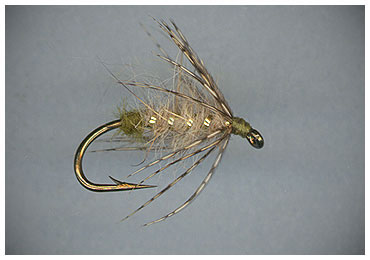 Diving Caddis 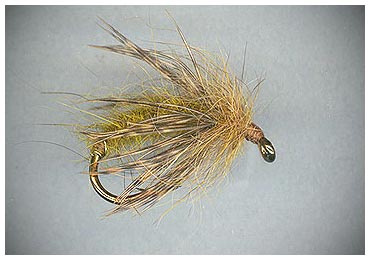 Triple Threat Caddis 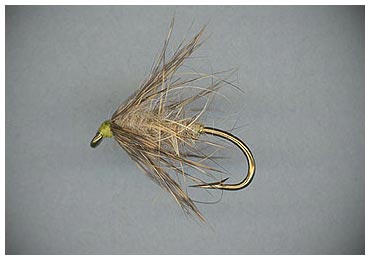 Leisenring Spider Hope these inspire. Mark | |
| "I have the highest respect for the skilled wet-fly fisherman, as he has mastered an art of very great difficulty." Edward R. Hewitt Flymphs, Soft-hackles and Spiders: http://www.troutnut.com/libstudio/FS&S/index.html | ||
| Sayfu | October 27th, 2011, 8:59 pm | |
| Posts: 560 | Inspire me. I can feel the tug already! And the "spiky" bodies can trap an air bubble, or bubbles that make the fly very attractive to fish as well. | |
| Jmd123 | October 27th, 2011, 9:07 pm | |
| Oscoda, MI Posts: 2611 | Mark, beautiful flies as usual! Jonathon | |
| No matter how big the one you just caught is, there's always a bigger one out there somewhere... | ||
| Softhackle | October 27th, 2011, 9:31 pm | |
Site Editor Wellsville, NYPosts: 540 | Vern Hidy perferred to tie his flymphs on up-eye hooks, especially for caddis flies, He felt they had a way of ascending in the column which made them appear more caddis-like.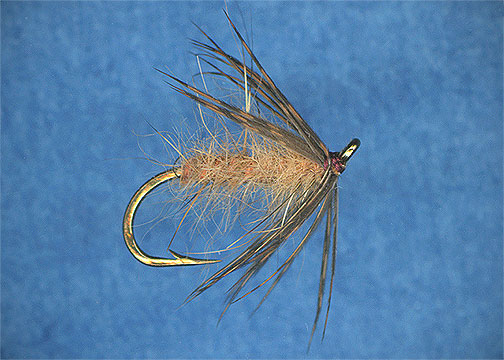 Hare and Grouse 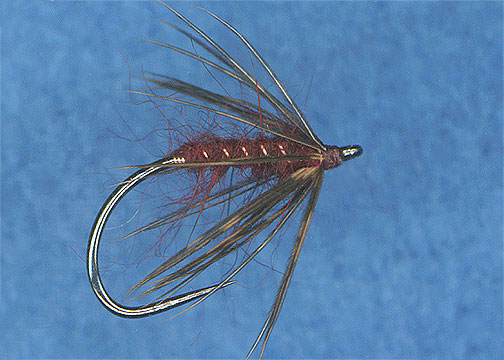 Claret Flymph  Olive Ascension Caddis. Sayfu, That air bubble is definitely part of flymph fishing. Mark | |
| "I have the highest respect for the skilled wet-fly fisherman, as he has mastered an art of very great difficulty." Edward R. Hewitt Flymphs, Soft-hackles and Spiders: http://www.troutnut.com/libstudio/FS&S/index.html | ||
| Entoman | October 27th, 2011, 10:05 pm | |
| Northern CA & ID Posts: 2604 | That beautifully tied Leisenring Spider is also one of may favorites for caddis. Add a few pheasant tail fibers for tails and you have what Dave Hughes christened the March Brown Soft-hackle. It has become very popular on the West Coast for imitating emerging Rhithrogena. The Triple Threat caddis also looks very similar to the way I tie another all-purpose favorite, the Bird's Nest (though I do blaspheme and tie at least a few of these with beads). The main difference is again the presence of tails. I clip them both off at the quick when used for caddis. Killing two stones with the same "Bird", so to speak, and saves space in my working box. BTW - Mark, was the Leisenring Spider also called the Hare's Ear Flymph by Hidy? Or am I thinking of a different pattern. Regards, Kurt Edit: Ha! Answered while I was writing unless you have more to add. | |
| "It's not that I find fishing so important, it's just that I find all other endeavors of Man equally unimportant... And not nearly as much fun!" Robert Traver, Anatomy of a Fisherman | ||
| Entoman | October 27th, 2011, 10:12 pm | |
| Northern CA & ID Posts: 2604 | Particularly the relationship between the two authors. I may be operating on a few false assumptions. | |
| "It's not that I find fishing so important, it's just that I find all other endeavors of Man equally unimportant... And not nearly as much fun!" Robert Traver, Anatomy of a Fisherman | ||
| Jesse | October 28th, 2011, 1:43 am | |
| Posts: 378 | The triple threat caddis looks great! I might have to incorporate that one into the old box! | |
| Most of us fish our whole lives..not knowing its not the fish that we are after. http://www.filingoflyfishing.com | ||
| Softhackle | October 28th, 2011, 10:02 am | |
Site Editor Wellsville, NYPosts: 540 | Hi Kurt, Hidy could have easily called the Leisenring Spider a Hare's Ear Flymph because it is. Sports Illustrated featured some articles by Hidy years ago and it was then worked into a book, The Sports Illustrated Book of Wet Fly Fishing. The illustrations show Hidy tying three different flies. One he calls the Leisenring Spider. This is that fly, dressed as Hidy describes. The book also outlines a few fishing techniques he used to fish these flies, including the well known Leisenring Lift. It's now out of print, but can be found, occasionally on sale at Ebay for a reasonable price. Kurt, Jesse, the Triple Threat Caddis was created by my good friend and Leisenring aficionado, Jim Slattery. Jim was also responsible for creating the famous Stimulator, although he rarely receives credit for it. Jim was a Californian, but now lives and operates Campfire Lodge Resort- complete with fly shop- on the Madison in West Yellowstone. The Triple Threat Caddis is a knock-out pattern that works beautifully, and it can be tied in a tan color as well. The pattern dressing can be found, here, tied by Jim himself:http://www.danica.com/FLYTIER/jslattery/olive_triple_threat_caddis.htm Mark | |
| "I have the highest respect for the skilled wet-fly fisherman, as he has mastered an art of very great difficulty." Edward R. Hewitt Flymphs, Soft-hackles and Spiders: http://www.troutnut.com/libstudio/FS&S/index.html | ||
| Entoman | October 28th, 2011, 2:23 pm | |
| Northern CA & ID Posts: 2604 | Thanks for clearing things up, Mark. I'll look for the book. BTW - the instructions for the pants leg dubbing method are a little hard to follow. I'm not faulting the author, it's kinda like trying to describe a spey cast.:) Some things just have to be seen, I guess. Is there any video you are aware of? Regards, Kurt | |
| "It's not that I find fishing so important, it's just that I find all other endeavors of Man equally unimportant... And not nearly as much fun!" Robert Traver, Anatomy of a Fisherman | ||
| Entoman | October 28th, 2011, 3:15 pm | |
| Northern CA & ID Posts: 2604 | Mark,Jim was also responsible for creating the famous Stimulator, although he rarely receives credit for it. Interesting.. There must be quite a back-story to this. I must admit that many knowledgeable anglers don't give much credit for this pattern to Mr. Kaufmann, anyway. It's a little hard to argue that hook substitutions and less dense hackle over head dubbing constitute a different pattern. It's nothing more than a variation of the Improved Sofa Pillow that preceded it by at least a decade, perhaps more. Attributing fly authorship and material application technique is a tricky business. For example, the Bird's Nest mentioned in this thread is generally acknowledged as a very unique fly from the creative vise of Cal Bird. But is it? His hair collar in front of the hackle was used by Polly Rosborough years before (Fleidermouse, Casual Dress). Where did Polly get the idea? Where does Poul Jorgenson fit in the mix? Is there some European that has the technique in print the vastly pre-dates them all? Not that I discount the possibility that these great tiers developed their techniques independently from whole cloth. Heck, I've come up with stuff countless times over the years only to find out later that somebody else got there first.:) Nor are dates easy to ascribe for precedent as creation dates and ascent to popularity (or showing up in print) are unique to each situation and highly variable. It's been said that we all stand on the shoulders that precede us and that very little is truly new under the sun. Regardless, it's the individual souls subtle and unique individual imprint put on their "creations" that makes them original in all the universe. Nothing has been exactly like them before or will be again. Close perhaps, but not the same. To me, this is a key attribute that makes it art... Best regards, Kurt | |
| "It's not that I find fishing so important, it's just that I find all other endeavors of Man equally unimportant... And not nearly as much fun!" Robert Traver, Anatomy of a Fisherman | ||
| Softhackle | October 28th, 2011, 3:55 pm | |
Site Editor Wellsville, NYPosts: 540 | Hi Kurt, Not that I know of. Those illustrations are actually from the book I suggested. Basically, it results in the folding over of the thread upon itself, then rolling it on the pantleg in one direction, while holding it taunt between the thumb and forefinger of the left hand. Once it is rolled and the thread begins to twist it is carefully lifted and twisted further using both hands as in the illustration. This brush can then be stored on stiff cards that have level slits on both sides to hold it in position. Mark | |
| "I have the highest respect for the skilled wet-fly fisherman, as he has mastered an art of very great difficulty." Edward R. Hewitt Flymphs, Soft-hackles and Spiders: http://www.troutnut.com/libstudio/FS&S/index.html | ||
| Oldredbarn | October 28th, 2011, 4:17 pm | |
| Novi, MI Posts: 2608 | It's been said that we all stand on the shoulders that precede us and that very little is truly new under the sun. Regardless, it's the individual souls subtle and unique individual imprint put on their "creations" that makes them original in all the universe. Nothing has been exactly like them before or will be again. Close perhaps, but not the same. To me, this is a key attribute that makes it art... Spoiler alert! Spence is going to carry on a bit here...If you are not interested do not read past this point. Stop it now...I mean it. :) Many, many, years ago I was driving truck at night for the Detroit Free Press in Detroit and working my way through college...One of the old watering holes of my friends and I had a nice pool table...There was a young, bare-footed, young siren who used to play there that tugged a bit on this old dutchman's heart strings...Or something like that. ;) I was doing all I possibly could to get her attention, which she understood, but to no avail...I knew she was a student as well and was an English major who wrote her own poetry...I tried to impress and she finally got around to asking me who my favorite poet was... I said, "T.S.Eliot". She looked at me and said, "I hate T.S.Eliot! He's so derivative!" Ouch! I muttered something about, "Who isn't" and gave up the hunt... "Nothing new under the sun." That's for sure! The Improved Sofa Pillow ended up the "Mattress Thrasher" along the Au Sable, which is a variation of the Stimulator etc...We just don't palmer a hackle through the abdomen so the fly 's body rests on the water. We leave out the tail as well. A great fly in different versions to rattle up Brown's when the stoneflies are about. http://www.danica.com/flytier/swilliams/swilliams.htm The link takes you to Steve Willian's page on Hans' web site. Toggle down to Yellow-Bellied Mattress Thrasher. Steve Williams has been hanging around the Au Sable since the 70's sometime and this is his version. Change the size and color to match the natural and bam! Spence | |
| "Even when my best efforts fail it's a satisfying challenge, and that, after all, is the essence of fly fishing." -Chauncy Lively "Envy not the man who lives beside the river, but the man the river flows through." Joseph T Heywood | ||
| Entoman | October 28th, 2011, 5:55 pm | |
| Northern CA & ID Posts: 2604 | Thanks, Mark. Too bad about the video but your added description helps a lot. Kurt | |
| "It's not that I find fishing so important, it's just that I find all other endeavors of Man equally unimportant... And not nearly as much fun!" Robert Traver, Anatomy of a Fisherman | ||
| Softhackle | October 28th, 2011, 7:44 pm | |
Site Editor Wellsville, NYPosts: 540 | Kurt, I think Dave Hughes shows a Clark Dubbing Block, which if made and used correctly, creates dubbing brushes very similar to this pant-leg technique. It's very simple to use, and one can sit and make dubbibg brushes easily, store them on cards till needed. Here's a link to Allen McGee's rendition, however, it should, in my opinion, have a piece if rough suede leather which the thread and dubbing lies on. This helps replicate the rolling of the brush on the pant-leg. http://www.flyanglersonline.com/flytying/tyingtips/part361.php Mark | |
| "I have the highest respect for the skilled wet-fly fisherman, as he has mastered an art of very great difficulty." Edward R. Hewitt Flymphs, Soft-hackles and Spiders: http://www.troutnut.com/libstudio/FS&S/index.html | ||
| Entoman | October 28th, 2011, 9:34 pm | |
| Northern CA & ID Posts: 2604 | Mark - Yes, you're right. I have Dave's book, Wet Flies where he has photo's of the gizmo as well as it's use and how to build one. I think your suede idea is clever as it would approximate the pant surface as opposed to the laminate that is recommended in the book. The pant leg technique you've introduced (at least to this angler) intrigues me though... I'm going to work at it 'till I get it down and check back in with any further frustrations for additional help:) Regards, Kurt | |
| "It's not that I find fishing so important, it's just that I find all other endeavors of Man equally unimportant... And not nearly as much fun!" Robert Traver, Anatomy of a Fisherman | ||
| Oldredbarn | October 28th, 2011, 10:10 pm | |
| Novi, MI Posts: 2608 | I think, in the "Benchside Guide",there are some illustrations and some other alternatives. The interesting thing...with this technique you can create nice buggy looking flies, or for neurotics like myself, incredibly uniform and thin bodies on them mayflies...Remember, there are only a couple that look a bit stocky or chunky...We tyer's tend to over size our imitations...Most of them could stand to diet and lose a little thickness. IMHO... Spence | |
| "Even when my best efforts fail it's a satisfying challenge, and that, after all, is the essence of fly fishing." -Chauncy Lively "Envy not the man who lives beside the river, but the man the river flows through." Joseph T Heywood | ||
| Softhackle | October 28th, 2011, 10:28 pm | |
Site Editor Wellsville, NYPosts: 540 | Spence, Jesse mentions the creation of an air bubble about the fly on buggy flies. This is exactly what Hidy wanted for his flymphs. He called it a hydrofuge, and suggested blotting the fly to dry it on paper towel between casts to help get the fly to trap air after each cast. So, there is some reasoning behind the buggy body. Here are two flymphs actually tied by Hidy. Despite the buggy quality, they still have a slender profile. Notice how the dubbing thins out near the tail end of the fly, showing the tying thread.  Notice the up-eye hooks. Mark | |
| "I have the highest respect for the skilled wet-fly fisherman, as he has mastered an art of very great difficulty." Edward R. Hewitt Flymphs, Soft-hackles and Spiders: http://www.troutnut.com/libstudio/FS&S/index.html | ||
| Entoman | October 28th, 2011, 11:57 pm | |
| Northern CA & ID Posts: 2604 | Mark - Hidy tied a nice fly. The quality of the hackle is amazing. Sure wished I had the necks they came from!:) Spence - ...Remember, there are only a couple that look a bit stocky or chunky...We tyer's tend to over size our imitations... I agree Spence. Try to buy them that way.:) That little baetid wingless wet's abdomen I've posted looks almost as thin as a bare hook in the hand. Regards, Kurt | |
| "It's not that I find fishing so important, it's just that I find all other endeavors of Man equally unimportant... And not nearly as much fun!" Robert Traver, Anatomy of a Fisherman | ||
| Softhackle | October 29th, 2011, 8:53 am | |
Site Editor Wellsville, NYPosts: 540 | Kurt. Leisenring/Hidy suggested varying hackle stiffness for different water speeds. They suggested Dotterel hackle, which means a feather from a young rooster. The stiffness resembles that of modern day genetic hen which offers great size variation, color vaiation, etc. To me, Brahma hen neck and Coq de leon hen neck are excellent examples of great modern day hackle available to tiers. Here's a soft-hackle I call Tinker Belle. It uses Brahma hen neck. 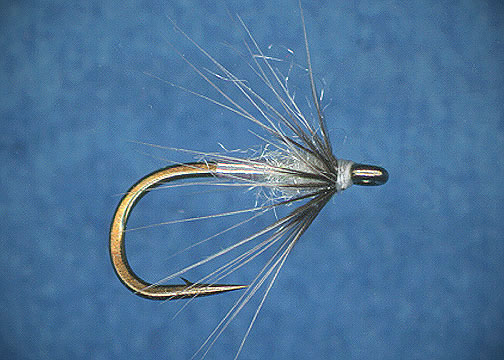 Mark | |
| "I have the highest respect for the skilled wet-fly fisherman, as he has mastered an art of very great difficulty." Edward R. Hewitt Flymphs, Soft-hackles and Spiders: http://www.troutnut.com/libstudio/FS&S/index.html | ||
| Sayfu | October 29th, 2011, 9:54 am | |
| Posts: 560 | Softhackle. I once attended a steelhead fly tying seminar knowing the angler was one of the very best Northwest steelhead anglers. One of his patterns he tied was a steelhead muddler minnow as a waking fly. He suggested the deer hair head NOT be packed tight, but left scrubby resulting in the space between hair having the capacity to trap air bubbles. I tied them scrubby, and would hold them down in the water, and could see the diamond sparkle of air bubbles trapped in the hair. Funny thing about those up eyed hooks. I seem to see proportion better, and don't crowd the head with the eye staring at me as apposed to a down eyed hook. But I seldom use the up eyed hooks on anything, but steelhead flies. | |
Quick Reply
You have to be logged in to post on the forum. It's this easy:
Related Discussions
| Title | Replies | Last Reply |
| Re: Modern Darbee Genetics In Fly Tying by Pabrookbum | 2 | Nov 27, 2021 by Wbranch |
| Re: 5 Wt Fly Rods In General Discussion by WestCO | 9 | Sep 19, 2012 by PaulRoberts |
| Re: Newbie In the Insect Order Trichoptera by GennieS | 2 | May 26, 2009 by Shawnny3 |
| Re: emerger fishing In General Discussion by Turboboy | 4 | Oct 28, 2011 by Sayfu |
| Emergence In Brachycentrus appalachia Caddisfly Adult by Martinlf | 0 | |
| Re: I don't know how this slipped by me!!! In Fly Tying by Oldredbarn | 3 | Mar 20, 2013 by Sayfu |
| Re: Has anyone heard of a Beaman's Ghost? In Fly Tying by Bcvizina | 1 | Mar 11, 2010 by Oldredbarn |
| Mosquito Adams In Fly Tying by Mcflyangler | 0 | |
| Re: Partridge Under-Feathers In Fly Tying by CAuletta | 2 | Jun 7, 2012 by CAuletta |
| CFFCM Arts of the Angler Show In General Discussion by Flymom | 0 |
Troutnut.com is copyright © 2004-2024 Jason
Neuswanger (email Jason). See my FAQ for information about use of my images.
 privacy policy
privacy policy





